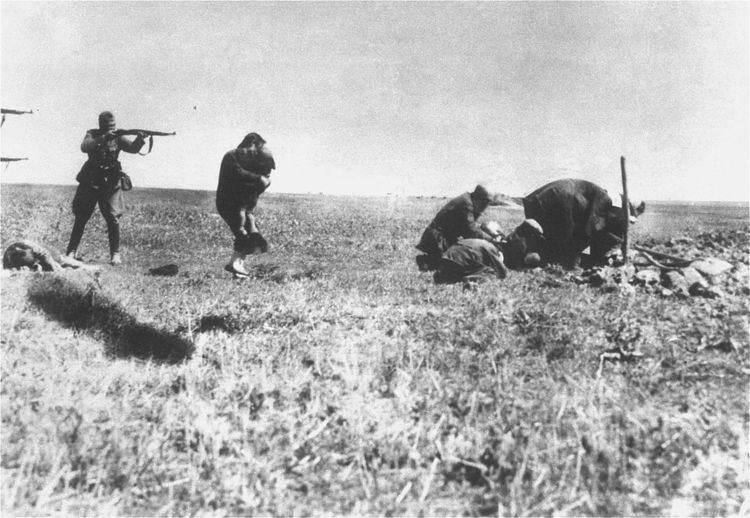 | ||
Date 22 June 1941 to late 1944 Incident type Imprisonment, mass shootings, concentration camps, ghettos, forced labor, starvation, torture, mass kidnapping Victims 3,000,000 Ukrainians, Romanis & other non-Jews (including Soviet POWs)800,000–950,000 Jews2,300,000 Ukrainians deported | ||
The Holocaust in Ukraine took place during the occupation of Ukraine by Nazi Germany. Between 1941 and 1945, approximately 3,000,000 Ukrainian and other non-Jewish victims were killed as part of Nazi extermination policies, along with between 800,000 to 950,000 Jews.
Contents
- Generalplan Ost
- Death squads 19411943
- Ukrainian collaborators
- Executor units
- Survivors
- Rescuers
- Massacres
- References
Original plans of genocide called for the extermination of 65% of the nation's 23.2 million Ukrainians, with the remainder of inhabitants to be treated as slaves. Over 2,300,000 Ukrainians were deported to Germany for slave labor. In ten years' time, the plan effectively called for the extermination, expulsion, Germanization or enslavement of most or all Ukrainians.
Generalplan Ost
One of Hitler's ambitions at the start of the war was to exterminate, expel, or enslave most or all Slavs from their native lands so as to make living space for German settlers. This plan of genocide was to be carried into effect gradually over a period of 25–30 years.
According to historian William W. Hagen, "Generalplan Ost . . . forecast the diminution of the targeted east European peoples' populations by the following measures: Poles – 85 percent; Belarusians – 75 percent; Ukrainians – 65 percent; Czechs – 50 percent. ... The Russian people, once subjugated in war, would join the four Slavic-speaking nations whose fate Generalplan Ost foreshadowed."
Death squads (1941–1943)
Total civilian losses during the war and German occupation in Ukraine are estimated at four million, including up to a million Jews who were murdered by the Einsatzgruppen and local Nazi collaborators. Einsatzgruppe C (SS-Gruppenführer Dr. Otto Rasch) was assigned to north and central Ukraine, and Einsatzgruppe D (SS-Gruppenführer Dr. Otto Ohlendorf) to Moldavia, south Ukraine, the Crimea, and, during 1942, the north Caucasus. According to Ohlendorf at his trial, "the Einsatzgruppen had the mission to protect the rear of the troops by killing the Jews, Romani, Communist functionaries, active Communists, uncooperative slavs, and all persons who would endanger the security." In practice, their victims were nearly all Jewish civilians (not a single Einsatzgruppe member was killed in action during these operations). The United States Holocaust Memorial Museum tells the story of one survivor of the Einsatzgruppen in Piryatin, Ukraine, when they killed 1,600 Jews on April 6, 1942, the second day of Passover:
From September 16–30, 1941 the Nikolaev massacre in and around the city of Mykolaiv resulted in the deaths of 35,782 Soviet citizens, most of whom were Jews, as was reported to Hitler.
The most notorious massacre of Jews in Ukraine was at the Babi Yar ravine outside Kiev, where 33,771 Jews were killed in a single operation on September 29–30, 1941. (An amalgamation of 100,000 to 150,000 Ukrainian and other Soviet citizens were also killed in the following weeks). The mass killing of Jews in Kiev was decided on by the military governor Major-General Friedrich Eberhardt, the Police Commander for Army Group South (SS-Obergruppenführer Friedrich Jeckeln) and the Einsatzgruppe C Commander Otto Rasch. It was carried out by a mixture of SS, SD and Security Police, assisted by the Ukrainian Auxiliary Police. On the Monday, the Jews of Kiev gathered by the cemetery, expecting to be loaded onto trains. The crowd was large enough that most of the men, women, and children could not have known what was happening until it was too late: by the time they heard the machine-gun fire, there was no chance to escape. All were driven down a corridor of soldiers, in groups of ten, and then shot. A truck driver described the scene:
Ukrainian collaborators
The National Geographic reported: " A number of Ukrainians had collaborated: According to German historian Dieter Pohl, around 100,000 joined police units that provided key assistance to the Nazis. Many others staffed the local bureaucracies or lent a helping hand during mass shootings of Jews. Ukrainians, such as the infamous Ivan the Terrible of Treblinka, were also among the guards who manned the Nazi death camps."
According to The Simon Wiesenthal Center (in January 2011) "Ukraine has, to the best of our knowledge, never conducted a single investigation of a local Nazi war criminal, let alone prosecuted a Holocaust perpetrator."
According to the Israeli Holocaust historian Yitzhak Arad, "In January 1942 a company of Tatar volunteers was established in Simferopol under the command of Einsatzgruppe 11. This company participated in anti-Jewish manhunts and murder actions in the rural regions."
Executor units
Survivors
Rescuers
Ukraine rates the 4th in the number of people recognized as "Righteous Among the Nations" for saving Jews during the Holocaust, with the total of 2,515 individuals recognized as of 1 January 2015.
The Shtundists, an evangelical Protestant denomination which emerged in late 19th century Ukraine, helped hide Jews.
